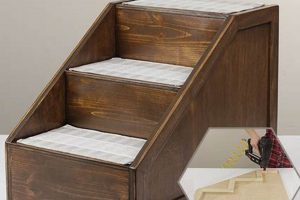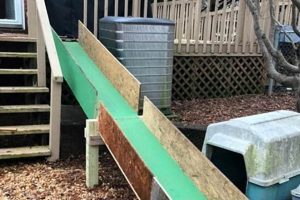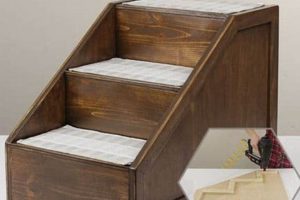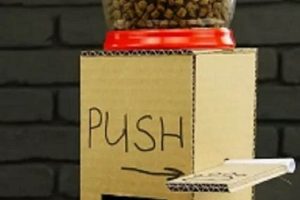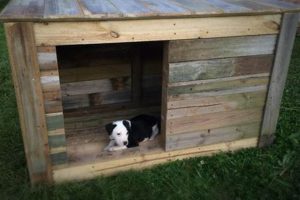The construction of containment solutions for canine companions using readily available materials and self-directed labor is a common practice among pet owners. This approach allows for tailored designs that suit specific needs and environments, often proving more cost-effective than professionally installed options. For example, a homeowner might choose to build a perimeter using repurposed pallets and sturdy hardware to create a barrier within their yard.
The advantages of such projects extend beyond mere budgetary savings. Owner-built enclosures permit customization based on a dog’s size, breed, and activity level, thereby ensuring a more secure and comfortable area. Historically, individuals have always sought ways to independently provide for their animals’ needs, and this is simply a modern adaptation of that long-standing tradition. Furthermore, completing a project like this can increase property value and enhance the aesthetic appeal of outdoor spaces.
The following discussion will delve into various design options, material considerations, and construction techniques for creating durable and effective boundaries for dogs. Aspects like fencing materials, height considerations, and methods for preventing digging or jumping will be examined in detail.
Construction Advice for Canine Containment Projects
Effective self-directed construction of canine enclosures requires careful planning and attention to detail. The following guidelines offer practical advice for ensuring a secure and functional barrier for pets.
Tip 1: Measure the Area Accurately: Before commencing any project, precise measurements of the intended enclosure are crucial. These measurements will dictate material quantities and ensure proper fence dimensions. Inaccurate calculations can lead to material shortages or a fence that fails to adequately contain the animal.
Tip 2: Select Appropriate Materials: Material choice should reflect the dogs breed, size, and behavior. For instance, robust breeds may require heavier-gauge wire or solid wood construction to prevent escapes. The selected materials must also be weather-resistant to ensure longevity.
Tip 3: Ensure Proper Post Installation: Fence post integrity is paramount. Posts should be buried deep enough to resist leaning or uprooting. Consider using concrete to anchor posts, particularly in areas with loose soil. Post depth should be at least one-third of the post’s above-ground height.
Tip 4: Consider Underground Barriers: Dogs prone to digging require preventative measures. Burying wire mesh or extending the fence material underground can deter digging attempts. A depth of at least 12 inches is recommended for buried barriers.
Tip 5: Prevent Jumping: For dogs that jump, increased fence height or angled extensions may be necessary. Consider adding an interior overhang to the top of the fence to discourage leaping over the barrier. A minimum fence height of six feet is recommended for larger breeds.
Tip 6: Secure Gates Properly: Gate hardware should be robust and designed for outdoor use. Self-latching mechanisms provide added security, preventing accidental openings. Ensure gates swing inward to deter outward pushing by the dog.
Tip 7: Regular Maintenance is Essential: Periodic inspection and maintenance are crucial for long-term functionality. Check for loose connections, damaged materials, and signs of wear. Prompt repairs will prevent minor issues from escalating into major problems.
Adhering to these guidelines will significantly increase the effectiveness and durability of self-constructed canine enclosures, providing a secure environment for pets.
With a secure enclosure established, attention can shift to other aspects of pet care and responsible ownership.
1. Material Selection
Material selection forms a cornerstone of any successful self-directed canine containment project. The chosen materials directly influence the fence’s durability, security, aesthetic integration with the surrounding environment, and overall cost-effectiveness. The selection process requires a balanced assessment of these factors to achieve optimal results.
- Durability and Weather Resistance
Material selection must prioritize resistance to environmental stressors. For instance, pressure-treated wood offers inherent protection against rot and insect infestation, extending the fence’s lifespan in humid climates. Metal fencing, especially when powder-coated, provides superior resistance to rust and corrosion. Conversely, untreated wood may require frequent maintenance and replacement, impacting long-term cost.
- Strength and Containment Capacity
The material’s inherent strength must match the dog’s size, breed, and behavior. Lightweight materials such as plastic netting are unsuitable for large or determined breeds, as they can be easily breached. Chain-link fencing, while strong, might not be aesthetically pleasing. Solid wood or heavy-gauge welded wire offer a balance of strength and visual appeal, but are more expensive.
- Aesthetic Integration and Cost
Material selection influences the fence’s aesthetic integration with the surrounding landscape. Natural wood fences blend seamlessly into wooded areas, while vinyl fencing provides a clean, modern look. Cost considerations must be weighed against aesthetic preferences. Less expensive options, like repurposed materials, may require more labor and offer a less polished appearance.
- Safety and Maintenance
The chosen materials should not pose a safety hazard to the dog or require excessive maintenance. Materials with sharp edges or splinters should be avoided. Regular maintenance, such as painting or staining wood, prevents deterioration and extends the fence’s lifespan. Low-maintenance options, like vinyl, offer convenience but may be more costly upfront.
In conclusion, thoughtful material selection is integral to the success of any self-directed canine containment project. Balancing considerations of durability, strength, aesthetics, cost, safety, and maintenance ensures that the final product meets the needs of both the dog and the owner, providing a secure and aesthetically pleasing enclosure.
2. Height Determination
Height determination represents a critical stage in the development of effective canine containment solutions. The selection of an adequate barrier height directly influences the enclosure’s ability to prevent escapes. Insufficient height constitutes a primary cause of fence ineffectiveness, particularly with breeds known for their jumping abilities or determined to breach boundaries. For example, a border collie, capable of clearing significant heights, requires a taller barrier than a dachshund. The failure to properly assess breed-specific physical capabilities results in unsuccessful self-directed fence projects, necessitating costly revisions or complete reconstruction.
Proper height assessment relies on several factors, including breed standards, individual dog characteristics, and environmental conditions. Breed standards provide a baseline for expected jumping heights, while observations of individual dogs offer insight into their specific capabilities. Environmental factors, such as the presence of nearby objects that can serve as jumping aids (e.g., trees, sheds), also contribute to the necessary fence height. A seemingly adequate height may prove insufficient if a dog can use an adjacent object to gain leverage. Understanding these nuances is vital for the practical application of DIY fence construction.
In summary, the adequate height of a canine enclosure is not arbitrary. It necessitates a careful evaluation of multiple, interconnected variables specific to the animal and its surroundings. Overlooking height determination during the planning phase of any DIY fencing project can lead to the need for extensive alterations or a total failure to contain the animal. The correlation between accurate height assessment and successful self-directed fence construction is therefore fundamental.
3. Dig Prevention
The consideration of dig prevention represents a critical component in successful canine containment projects undertaken through do-it-yourself methods. A significant number of canines exhibit a propensity for digging, which can compromise the integrity of a fence, rendering it ineffective. The absence of proactive dig prevention measures often results in escape, undermining the intended purpose of the enclosure. For example, a homeowner constructs a perimeter fence with adequate height but fails to address the possibility of digging. The dog subsequently excavates beneath the barrier, achieving escape and negating the time and resources invested in the project. Therefore, the integration of dig prevention strategies is not merely an optional enhancement, but a necessary element in any comprehensive canine enclosure design.
Effective dig prevention strategies encompass several construction techniques. The burial of wire mesh or chain-link fencing extending horizontally outward from the base of the fence provides a physical barrier that discourages excavation. The placement of large rocks or concrete pavers along the fence line presents an additional deterrent. Another approach involves creating an L-shaped footer by bending the bottom portion of the fence material outward and burying it. The L-shape acts as a barrier, redirecting the dog’s digging efforts away from the fence line. Real-world implementations demonstrate that these proactive measures significantly reduce the likelihood of escape. For instance, a dog owner implemented an L-shaped footer along their fence perimeter, which effectively ended their dogs persistent digging attempts and secured their yard.
In conclusion, neglecting dig prevention undermines the efficacy of canine containment projects, necessitating a comprehensive approach. The integration of techniques such as buried barriers, strategic placement of rocks or pavers, and the creation of L-shaped footers significantly reduces the possibility of escape. The commitment to incorporating these measures underscores the importance of thorough planning and execution in self-directed canine enclosure projects, ensuring a secure and reliable environment. Dig prevention is therefore a fundamental element for any dog owner endeavoring to construct their own fence.
4. Gate Security
Gate security represents a critical, often undervalued, aspect of self-constructed canine containment systems. The gate, as a point of ingress and egress, constitutes a potential weak point in an otherwise robust perimeter. Compromised gate security negates the benefits of a well-designed fence, rendering the entire enclosure ineffective. Therefore, meticulous attention to gate design and hardware selection is paramount.
- Latch Mechanisms
The latch mechanism serves as the primary security feature of a gate. Gravity latches, while common, are susceptible to accidental disengagement. Self-latching mechanisms, incorporating spring-loaded bolts, offer enhanced security, preventing unintentional openings caused by wind or animal contact. Consider lockable latches for added security, particularly for dogs prone to escaping.
- Hinge Integrity
Gate hinges must withstand repeated use and environmental stressors. Heavy-duty hinges, constructed from robust materials like stainless steel, provide increased durability compared to lighter-gauge options. Ensure hinges are properly aligned and securely fastened to both the gate and the fence post to prevent sagging or failure. Regular inspection and lubrication of hinges contribute to long-term functionality.
- Frame Reinforcement
The gate frame must possess sufficient structural integrity to resist warping or breakage. Constructing the frame from durable materials, such as pressure-treated lumber or welded metal, ensures longevity. Reinforce corners with metal brackets or gussets to enhance stability. A sagging or warped gate compromises the latching mechanism and reduces overall security.
- Clearance and Ground Contact
Maintaining minimal clearance between the gate and the ground prevents digging beneath the gate. Conversely, excessive ground contact impedes gate operation and accelerates wear. Adjust the gate height during installation to achieve optimal clearance. Consider installing a buried barrier beneath the gate threshold to further deter digging attempts.
In conclusion, gate security forms an indispensable element of self-directed canine containment strategies. Proper latch selection, hinge integrity, frame reinforcement, and ground clearance collectively contribute to a secure and reliable entry point. Neglecting gate security undermines the overall effectiveness of the fence, potentially leading to escape. A well-executed gate design complements the surrounding fence, providing peace of mind to dog owners.
5. Post Stability
Post stability directly correlates with the long-term efficacy of self-constructed canine containment systems. Fence posts serve as the foundational support for the entire structure; their stability dictates the fence’s resistance to external forces such as wind, animal impact, and ground shifting. When engaging in do-it-yourself fence construction, inadequate post installation invariably leads to fence failure. For example, a fence erected with shallowly buried or improperly secured posts is susceptible to leaning or collapsing, creating gaps that permit canine escape. This underscores the cause-and-effect relationship: unstable posts cause fence instability, leading to containment breaches.
The importance of robust post installation techniques is paramount within the context of owner-built enclosures. Proper depth of post burial, typically one-third to one-half of the above-ground post height, is essential. Concrete encasement of the posts within the ground offers enhanced stability, particularly in areas with loose or unstable soil. Furthermore, the selection of weather-resistant post materials, such as pressure-treated lumber or galvanized steel, minimizes the risk of rot or corrosion, thereby preserving the structural integrity of the posts over time. A homeowner who invests in durable posts and proper installation methods realizes a significantly longer lifespan for the fence, minimizing maintenance and replacement costs.
In summary, post stability constitutes an indispensable element of successful self-directed canine fencing projects. The failure to prioritize proper post installation leads to compromised fence integrity and potential animal escape. Adhering to established best practices for post depth, anchoring, and material selection significantly enhances the fence’s durability and effectiveness, ensuring long-term canine containment. Recognizing and addressing the foundational role of post stability is crucial for responsible pet ownership and successful do-it-yourself fence construction.
6. Cost Effectiveness
The consideration of cost effectiveness is integral to the decision-making process for individuals pursuing self-directed canine containment solutions. Financial constraints often dictate the scope and complexity of fencing projects, compelling owners to prioritize affordability while maintaining a reasonable level of security and durability. This section explores specific facets of cost effectiveness as they relate to practical, owner-built fencing solutions.
- Material Sourcing and Repurposing
The selection of materials exerts a direct influence on the overall project cost. Utilizing reclaimed or repurposed materials, such as wooden pallets or recycled fencing, can significantly reduce expenses compared to purchasing new materials. For example, obtaining free or low-cost pallets from local businesses and disassembling them for fence construction minimizes material costs. However, repurposed materials may require additional labor for preparation and treatment to ensure safety and longevity.
- Labor Input and Skill Level
The degree of labor involved and the requisite skill level impact the overall cost. While self-directed construction eliminates professional installation fees, it demands time and effort from the owner. Projects requiring specialized skills, such as welding or advanced carpentry, may necessitate the rental of tools or the procurement of assistance, thereby increasing expenses. Simpler designs, employing readily available materials and basic construction techniques, offer greater cost savings for individuals with limited experience.
- Design Simplicity and Scalability
The complexity of the fence design correlates directly with material requirements and labor hours. Opting for a straightforward, linear design, as opposed to intricate or decorative patterns, minimizes material waste and simplifies construction. Scalability allows for phased construction, enabling owners to address immediate containment needs while deferring less critical sections. A modular design, using prefabricated panels, offers flexibility and facilitates future expansion or modification.
- Long-Term Maintenance Costs
The initial cost of a fencing project does not fully reflect its economic impact. Materials with low upfront costs may incur higher maintenance expenses over time. For example, untreated wood requires regular sealing or painting to prevent rot and decay, adding to the overall cost. Investing in durable, weather-resistant materials, such as pressure-treated lumber or vinyl fencing, reduces the need for frequent repairs or replacements, potentially offsetting the higher initial investment.
These facets of cost effectiveness highlight the multifaceted nature of financial considerations in self-directed canine enclosure projects. Careful planning, resourcefulness in material sourcing, realistic assessment of skill level, and attention to long-term maintenance collectively contribute to the creation of affordable and functional fencing solutions. By balancing cost constraints with security requirements, dog owners can achieve optimal results within their budgetary limitations.
Frequently Asked Questions
The following questions address common concerns regarding the construction of enclosures for dogs using self-directed methods. Answers are provided with the intent of offering practical guidance and ensuring project success.
Question 1: What is the minimum recommended fence height for containing a dog?
The minimum recommended fence height varies depending on the breed, size, and jumping ability of the dog. As a general guideline, a fence height of four feet is sufficient for smaller, less athletic breeds. Larger, more agile breeds may necessitate a fence height of five to six feet or higher to prevent escapes.
Question 2: How can digging under the fence be effectively prevented?
Digging under the fence can be deterred by burying wire mesh or hardware cloth horizontally outward from the base of the fence. A depth of at least 12 inches is recommended. Alternatively, concrete pavers or large rocks can be placed along the fence line to obstruct digging attempts.
Question 3: What type of fencing material is most durable and cost-effective?
Pressure-treated lumber offers a balance of durability and cost-effectiveness. It resists rot and insect infestation, extending the fence’s lifespan. Chain-link fencing provides strength but may lack aesthetic appeal. Vinyl fencing offers low maintenance but typically has a higher initial cost.
Question 4: How deep should fence posts be set for optimal stability?
Fence posts should be set at a depth of at least one-third of their above-ground height. For example, a six-foot post should be buried at least two feet deep. Concrete encasement of the posts is recommended for enhanced stability, particularly in areas with loose soil.
Question 5: What features should be incorporated into gate design for maximum security?
Gate design should prioritize robust latch mechanisms, such as self-latching or lockable latches. Hinges should be heavy-duty and securely fastened. The gate frame should be reinforced to prevent sagging. Minimal clearance between the gate and the ground prevents digging underneath.
Question 6: How often should a self-constructed fence be inspected for maintenance?
A self-constructed fence should be inspected at least twice per year, ideally in the spring and fall. Check for loose connections, damaged materials, signs of rot or corrosion, and any gaps or breaches in the perimeter. Prompt repairs prevent minor issues from escalating into major problems.
Careful consideration of these factors ensures that a self-constructed canine enclosure provides a secure and reliable environment for pets.
This concludes the discussion regarding frequently asked questions about self-constructed canine enclosures. The subsequent section will address the broader implications of responsible pet ownership.
Concluding Remarks on Canine Containment Projects
The preceding discussion has elucidated key considerations for self-directed canine containment solutions. From material selection and height determination to dig prevention, gate security, and post stability, the success of “dog fence ideas diy” projects relies on thorough planning and meticulous execution. Neglecting any of these facets undermines the overall efficacy of the enclosure.
As pet ownership carries inherent responsibilities, proper containment ensures canine safety and minimizes potential disturbances to the community. Implementing effective barrier solutions, guided by sound construction principles, reflects a commitment to responsible stewardship and fosters harmonious co-existence. Continuing to evaluate and refine these containment strategies remains imperative.


